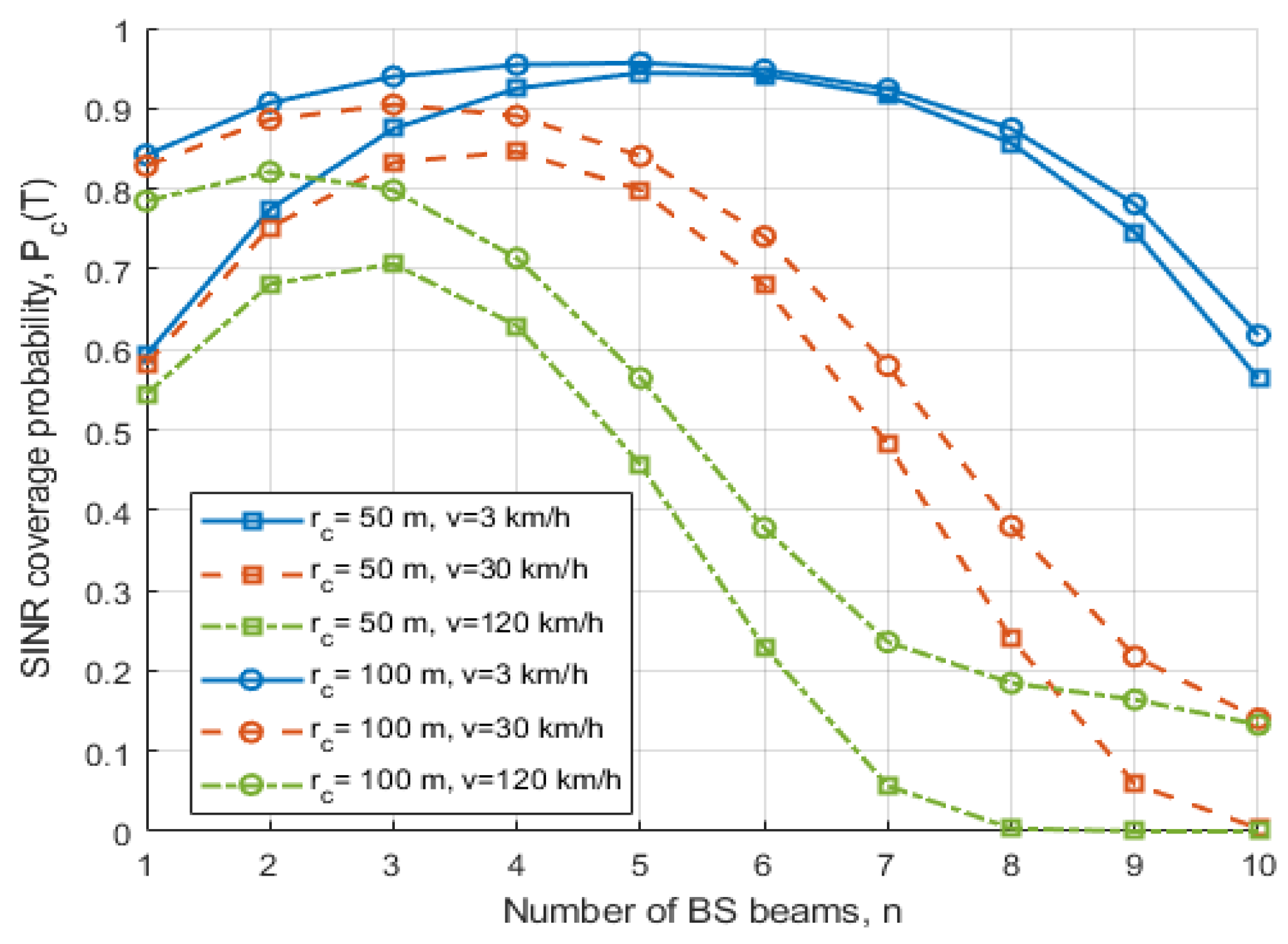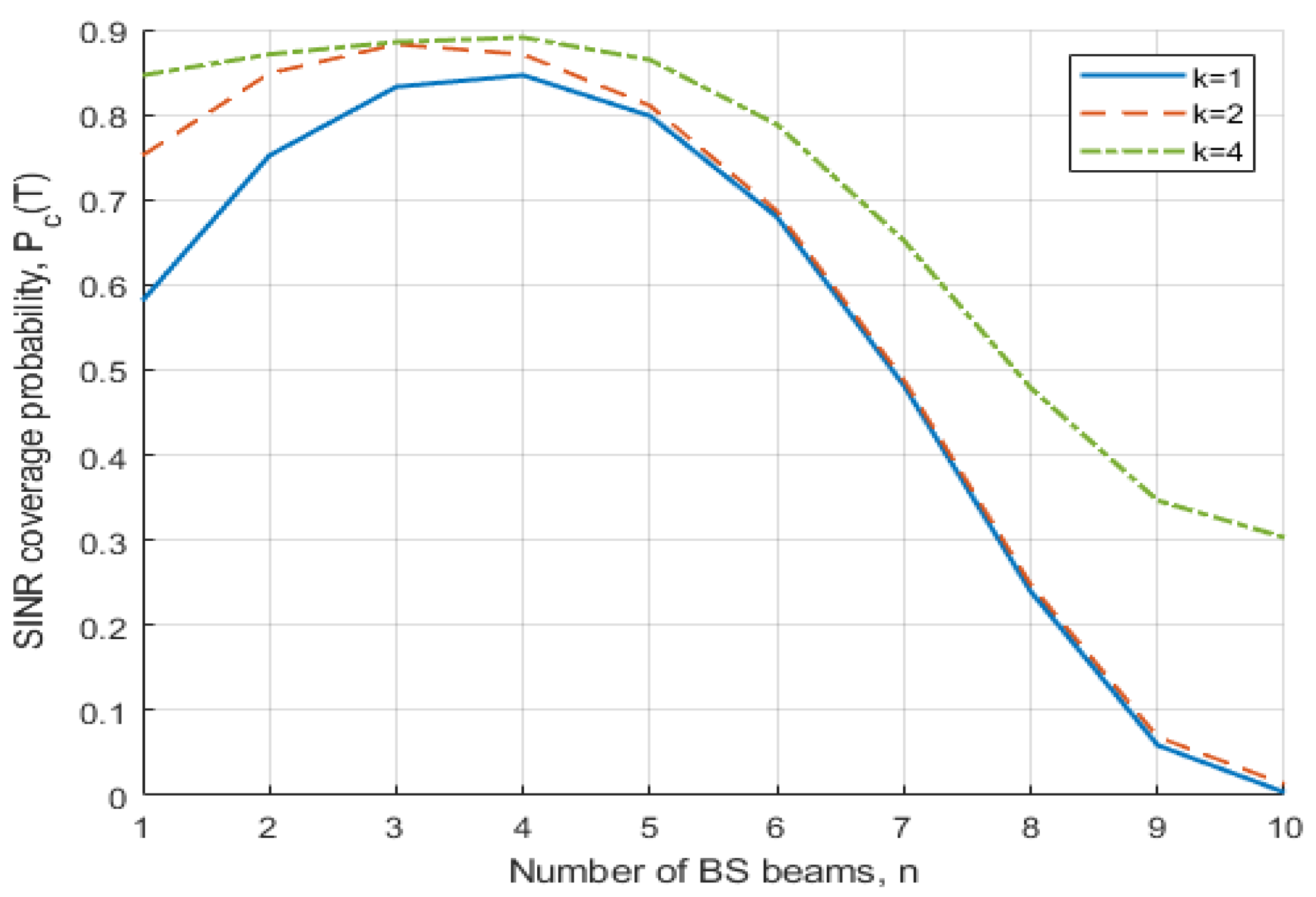Impact of Multiple Beams and Mobility-Based Beam Alignment Error on Millimeter Wave Communication †
Abstract
:1. Introduction
2. System Model
3. Analysis of SINR Coverage Probability
4. Numerical Results and Discussion
5. Conclusions
Author Contributions
Funding
Data Availability Statement
Conflicts of Interest
References
- Rappaport, T.S.; Xing, Y.; MacCartney, G.R.; Molisch, A.F.; Mellios, E.; Zhang, J. Overview of Millimeter Wave Communications for Fifth-Generation (5G) Wireless Networks—With a Focus on Propagation Models. IEEE Trans. Antennas Propag. 2017, 65, 6213–6230. [Google Scholar] [CrossRef]
- MacCartney, G.R.; Samimi, M.K.; Rappaport, T.S. Exploiting directionality for millimeter-wave wireless system improvement. In Proceedings of the 2015 IEEE International Conference on Communications (ICC), London, UK, 8–12 June 2015; pp. 2416–2422. [Google Scholar]
- Nitsche, T.; Flores, A.B.; Knightly, E.W.; Widmer, J. Steering with Eyes Closed: Mm-Wave Beam Steering without In-Band Measurement. In Proceedings of the 2015 IEEE Conference on Computer Communications (INFOCOM), Hong Kong, China, 26 April 2015–1 May 2015. [Google Scholar]
- Andrews, J.G.; Bai, T.; Kulkarni, M.N.; Alkhateeb, A.; Gupta, A.K.; Heath, R.W. Modeling and analyzing millimeter wave cellular systems. IEEE Trans. Commun. 2016, 65, 403–430. [Google Scholar] [CrossRef] [Green Version]
- Singh, S.; Kulkarni, M.N.; Ghosh, A.; Andrews, J.G. Tractable model for rate in self-backhauled millimeter wave cellular networks. IEEE J. Sel. Areas Commun. 2015, 33, 2196–2211. [Google Scholar] [CrossRef] [Green Version]
- Kalamkar, S.S.; Baccelli, F.; Abinader, F.M.; Marcano Fani, A.S.; Uzeda Garcia, L.G. Beam Management in 5G: A Stochastic Geometry Analysis. IEEE Trans. Wirel. Commun. 2021, 21, 2275–2290. [Google Scholar] [CrossRef]
- Di Renzo, M. Stochastic geometry modeling and analysis of multi-tier millimeter wave cellular networks. IEEE Trans. Wirel. Commun. 2015, 14, 5038–5057. [Google Scholar] [CrossRef] [Green Version]
- Turgut, E.; Gursoy, M.C. Coverage in heterogeneous downlink millimeter wave cellular networks. IEEE Trans. Commun. 2017, 65, 4463–4477. [Google Scholar] [CrossRef]
- Cheng, M.; Wang, J.-B.; Wu, Y.; Xia, X.-G.; Wong, K.-K.; Lin, M. Coverage analysis for millimeter wave cellular networks with imperfect beam alignment. IEEE Trans. Veh. Technol. 2018, 67, 8302–8314. [Google Scholar] [CrossRef] [Green Version]
- Yang, G.; Member, S.; Du, J.; Xiao, M.; Member, S. Analysis on 60 GHz Wireless Communications with Beamwidth-Dependent Misalignment. arXiv 2016, arXiv:1611.07867. [Google Scholar]
- Wildman, J.; Nardelli, P.H.J.; Latva-aho, M.; Weber, S. On the joint impact of beamwidth and orientation error on throughput in directional wireless poisson networks. IEEE Trans. Wirel. Commun. 2014, 13, 7072–7085. [Google Scholar] [CrossRef]
- Bai, T.; Heath, R.W. Coverage and Rate Analysis for Millimeter-Wave Cellular Networks. IEEE Trans. Wirel. Commun. 2015, 14, 1100–1114. [Google Scholar] [CrossRef]
- Yang, G.; Xiao, M. Performance Analysis of Millimeter-Wave Relaying: Impacts of Beamwidth and Self-Interference. IEEE Trans. Commun. 2018, 66, 589–600. [Google Scholar] [CrossRef] [Green Version]
- Mariam, H.; Ahmed, I.; Aslam, M.I. Coverage probability of uplink millimeter wave cellular network with non-homogeneous interferers’ point process. Phys. Commun. 2021, 45, 101274. [Google Scholar] [CrossRef]


Publisher’s Note: MDPI stays neutral with regard to jurisdictional claims in published maps and institutional affiliations. |
© 2022 by the authors. Licensee MDPI, Basel, Switzerland. This article is an open access article distributed under the terms and conditions of the Creative Commons Attribution (CC BY) license (https://creativecommons.org/licenses/by/4.0/).
Share and Cite
Mariam, H.; Ahmed, I.; Aslam, M.I. Impact of Multiple Beams and Mobility-Based Beam Alignment Error on Millimeter Wave Communication. Eng. Proc. 2022, 20, 42. https://doi.org/10.3390/engproc2022020042
Mariam H, Ahmed I, Aslam MI. Impact of Multiple Beams and Mobility-Based Beam Alignment Error on Millimeter Wave Communication. Engineering Proceedings. 2022; 20(1):42. https://doi.org/10.3390/engproc2022020042
Chicago/Turabian StyleMariam, Hira, Irfan Ahmed, and Muhammad Imran Aslam. 2022. "Impact of Multiple Beams and Mobility-Based Beam Alignment Error on Millimeter Wave Communication" Engineering Proceedings 20, no. 1: 42. https://doi.org/10.3390/engproc2022020042
APA StyleMariam, H., Ahmed, I., & Aslam, M. I. (2022). Impact of Multiple Beams and Mobility-Based Beam Alignment Error on Millimeter Wave Communication. Engineering Proceedings, 20(1), 42. https://doi.org/10.3390/engproc2022020042






